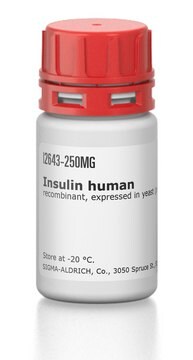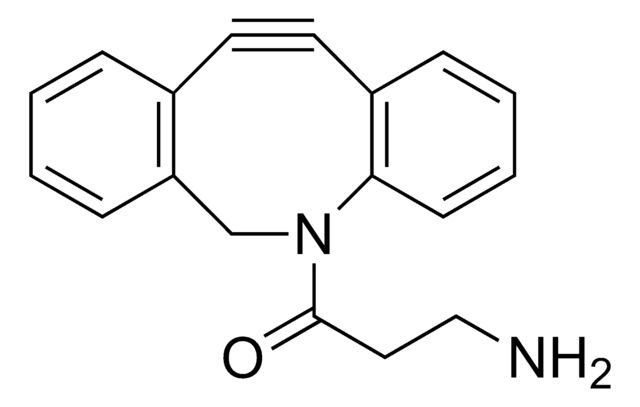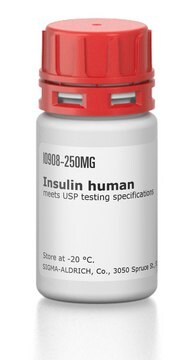推薦產品
生物源
human
重組細胞
expressed in E. coli
化驗
≥90% (SDS-PAGE)
形狀
aqueous solution
分子量
58.8 kDa
包裝
pkg of 20 μg
儲存條件
avoid repeated freeze/thaw cycles
濃度
>0.02 mg/mL
NCBI登錄號
UniProt登錄號
運輸包裝
dry ice
儲存溫度
−70°C
基因資訊
human ... PTPRN(5798)
一般說明
PTPRN (protein tyrosine phosphatase, receptor type N), more commonly known as IA-2 (insulinoma-associated protein 2), is a transmembrane protein of the PTP family. It was initially identified as a major autoantigen in type-1 diabetes mellitus. In neuroendocrine cells, it resides in the secretory granules. It is a multi-domain protein with intracellular, transmembrane and extracellular domains, and its intracellular region contains a pseudocatalytic domain. It gets processed multiple times during its life cycle, and its different parts are exposed to different cellular and tissue regions such as nucleus, cytosol, organellar lumen in the secretory pathway, extracellular pancreatic islet space, and membrane compartments. This gene is localized to human chromosome 2q35, and codes for a protein of 979 residues.
Protein tyrosine phosphatase. (PTP-IA2, ICA-512), Catalytic domain, (amino acids 693- 979), (Gene bank accession no. NM_002846), with N-terminal GST tag, MW = 58.8 kDa, expressed in an E. coli expression system.
應用
Useful for the study of enzyme kinetics, regulation, and to dephosphorylate target substrates.
生化/生理作用
PTPRN (protein tyrosine phosphatase, receptor type N) is cleaved at the cytosolic domain during insulin secretion. The cytosolic domain is relocated to nucleus where it promotes insulin gene transcription. This protein plays important role in hormone and neuropeptide secretion. This protein is crucial in controlling the dense core vesicle number in β cells and glucose-induced and basal insulin release. PTPRN null mice show reduced dense core vesicle (DCV) number, abnormal insulin secretion, female infertility, behavioral alteration, and circadian dysregulation.
單位定義
One unit will hydrolyze 1 pmol 6, 8-difluoro-4-methyl umbelliferyl phosphate (DiFMUP) per minute at pH 6.3 and 30°C.
外觀
Formulated in 25 mM Tris-HCl, pH 8.0, 75 mM NaCl, 0.05% Tween-20, 50% glycerol, 2 mM EDTA, 1 mM DTT, and 10 mM glutathione.
準備報告
Thaw on ice. Upon first thaw, briefly spin tube containing enzyme to recover full content of the tube. Aliquot enzyme into single use aliquots. Store remaining undiluted enzyme in aliquots at -70°C. Note: Enzyme is very sensitive to freeze/thaw cycles.
從最近期的版本中選擇一個:
Structure of the mature ectodomain of the human receptor-type protein-tyrosine phosphatase IA-2.
Primo ME
The Journal of Biological Chemistry, 283, 4674-4681 (2008)
The dense core transmembrane vesicle protein IA-2 is a regulator of vesicle number and insulin secretion.
Harashima S
Proceedings of the National Academy of Sciences of the USA, 102, 8704-8709 (2005)
Tao Cai et al.
Acta diabetologica, 52(3), 573-580 (2014-12-22)
IA-2 is a transmembrane protein found in the dense-core vesicles (DCV) of neuroendocrine cells and one of the major autoantigens in type 1 diabetes. DCV are involved in the secretion of hormones (e.g., insulin) and neurotransmitters. Stimulation of pancreatic β
María E Primo et al.
PloS one, 6(9), e24191-e24191 (2011-09-22)
ICA512 (or IA-2) is a transmembrane protein-tyrosine phosphatase located in secretory granules of neuroendocrine cells. Initially, it was identified as one of the main antigens of autoimmune diabetes. Later, it was found that during insulin secretion, the cytoplasmic domain of
我們的科學家團隊在所有研究領域都有豐富的經驗,包括生命科學、材料科學、化學合成、色譜、分析等.
聯絡技術服務








